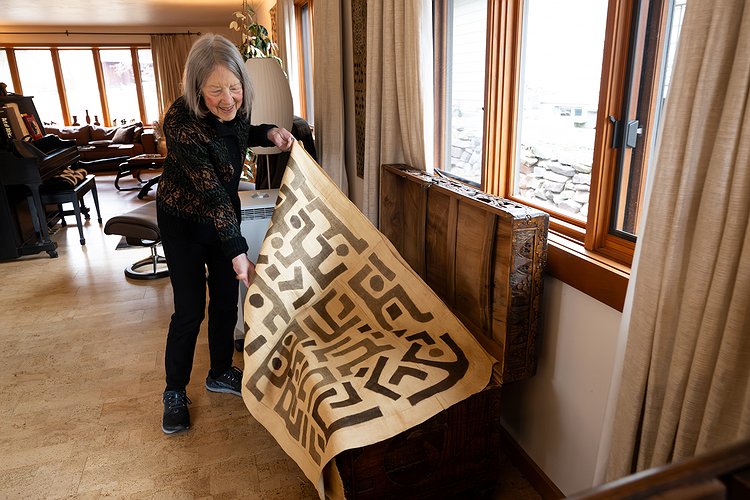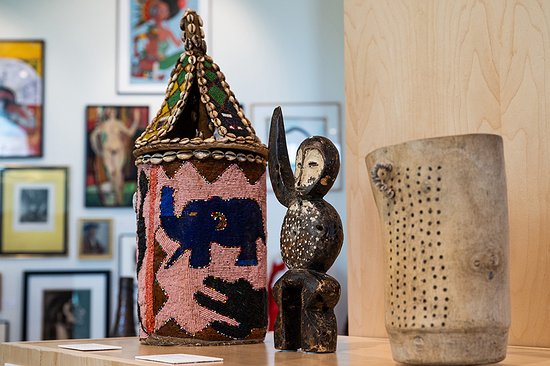UM law school alumna donates African art collection to museum
MISSOULA – For as far back as she can remember, University of Montana law school alumna Molly Shepherd has been drawn to the intricate dance of fibers and motifs of weavings and textiles.
She remembers drawing patterns with a compass and protractor as a child and papering her bedroom walls – when allowed by her mother – in burlap. Decades later, traveling around the country for work and pleasure, she developed an affinity for African fabrics and slowly assembled the extensive collection of textiles and art that she is gifting to UM’s Montana Museum of Art and Culture.
“The gift of Molly’s world-class African art takes the MMAC’s Permanent Collection in an exciting and truly global direction,” said Dr. Rafael Chacón, the Suzanne and Bruce Crocker Director of the MMAC. “Her gift is in keeping with a long history of foundational gifts, particularly by dedicated female collectors, making ours the most comprehensive art museum in Montana.”
Shepherd insists she never set out to be a collector.
“There was an innate appeal to the pieces that I’ve purchased,” said Shepherd from her warm and art-filled home in Missoula. “These things just grab you, and it’s hard to articulate and explain why. But it certainly happened to me with African art. I tend to like natural colors, I like texture, I like the dynamism and the asymmetry.
“I am not into pink and pretty I guess,” she added.
Originally from California, Shepherd studied history at Swarthmore College and Smith College on the East Coast before transferring to UM’s Blewett School of Law when she moved to Missoula in the mid-1970s.
For the next 30 years or so, as she traveled to major cities like Boston and Chicago, she explored markets and galleries looking for pieces that captured her eye.
“On the Lower East Side of New York City, there was a warehouse where African artists and vendors had booths. I wandered around and picked up some interesting things,” she recalled.
Another of her favorite haunts is the internationally known African Art Village in Tucson, Arizona.
“Every February, African artists, traders and gallery owners from across the country bring wares, and I’ve bought quite a few pieces there over the years,” she said, noting that she’d purposely leave Missoula with lightly packed bags to make room for her acquisitions. “I did have to ship a fair number of items home.”
With each African piece she purchased, Shepherd learned more about the cultures that produced them, the interplay of the artists at work and the significance of symbolism.
Eventually, the core of her collection of textiles focused on pieces created with raffia fiber and crafted by the Kuba people of the Democratic Republic of Congo. While many are singular decorative pieces, others were woven to be worn as skirts and wraps.
“There are some long-standing traditions to making these textiles,” she explained while gently pulling a panel from an ornately carved Chinese chest handed down in her family.
“The men and women collaborate, with the men weaving the base and the women the adornment and decoration. All the stitching is done by hand,” she said.
Asymmetry and the eclectic grouping of symbols appeal to Shepherd’s eye, as do the abstract patterns of “velvets” – another Kuba textile made by cutting raffia pile to create a rug-like fabric.
"I bought three or so ‘velvets’ back in the late-’80s and brought them home and lived with them and became intrigued with them – their makers and what they were about,” Shepherd said.
When asked how many textiles she owns, Shepherd, in the mark of a true collector, takes a minute to answer. It’s hard to tally what you have collected out of love more than investment.
“I have about 75 of the velvets. And I am not sure how many skirts, but I’m going to say 30 to 40,” she said. “Just a guess!”
In addition to textiles, Shepherd has collected a diversity of functional items such as baskets, headrests, masks, shields and weapons from Ethiopia and eastern central Africa and symbolic objects and prestige items from a variety of societies from Nigeria to South Africa.
“Utilitarian objects are important for a museum of art and culture,” Chacón said. “Molly’s collection focuses on both historic utility and cultural significance, as well as materiality and integrity of design.”
Shepherd said decisions on what to purchase over the years have been relatively easy, but occasionally a piece would come along that required contemplation. The perfect example is a boli displayed at MMAC’s opening exhibition in September 2023.
Amorphously shaped with four “legs” and a back hump, a boli is a sacred object to the Bamana people of Mali, containing ceremonial elements and human or animal parts that include placentas and other tissues such as bone and skin. It is made by a secret male society over time with repeated baths of clay, beer and bodily fluids.
“It’s a very powerful piece, and I knew I really wanted to have it,” Shepherd recalled of the Tucson purchase. “But I was awake much of the night deliberating whether to go back the next day and make an offer. I did.”
In her second home on the North Fork of the Flathead, she displays some of her larger works. The house itself has garnered numerous accolades for its fire-resistant construction that includes concrete and metal siding. The 2003 Wedge Canyon Fire came within one-fourth mile of her original wooden cabin, she said. Today, Shepherd is the co-chair of the Fire Mitigation Committee for the North Fork Landowners Association.
“As a landowner you need to do what you can do to not put firefighters and other people in harm’s way,” Shepherd says.
The North Fork home also houses a large rug loom for her personal weaving. She sometimes carries art pieces between her Glacier and Missoula homes – packing them carefully along with her beloved Cairn terrier Duffy.
Retired since 2003, Shepherd still lends her professional expertise to one of her favorite nonprofits, the Montana Justice Foundation, and its support of organizations providing legal services to vulnerable and underserved Montanans.
“One of the wonderful things about practicing law is working with the people who you come to know,” said Shepherd, who once served as president of the State Bar of Montana.
Shepherd regrets that she never traveled to Africa at some point along the way, but a busy career and raising two children – her daughter Kate lives in Santa Fe, New Mexico, and son Nat lives in Missoula – would have made the trips a challenge. Such an arduous adventure now, she adds, is unlikely.
Still, her passion for African art has not ebbed, nor has her belief in the value of learning from other cultures.
“I love this art. I am just so drawn to it. And I want other people to be able to share and to learn from it,” she said. “It would behoove us all to know more about other cultures. It helps us lead more complete lives if we have a better understanding of other people and what they care about.”
Shepherd anticipates that ownership of her collection will pass to MMAC on her death and become part of its Permanent Collection. In the meanwhile, she is donating items from her collection to the museum during her lifetime. Shepherd and the MMAC have entered into a collaborative interim agreement that allows the museum to display the works in its new building on the UM campus. According to the agreement, the collection will be available to the MMAC for “educational, aesthetic, cultural and charitable purposes.”
In addition to the gift of art, Shepherd has provided gifts to the UM Foundation to support the construction of the donor-funded MMAC building that opened in 2023 and the Alexander Blewett School of Law at UM.
“One of the reasons I think the MMAC is so important is because it’s an institution that combines artistic expression with developing an understanding of the cultures that produced them,” Shepherd said. “It is such a valuable asset, and we are so fortunate to have it as a part of our community.”






